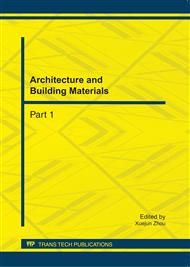[1]
G. F. Zhao. Advanced reinforced concrete structure. (China electric power press, Beijing, 1999). (in Chinese)
Google Scholar
[2]
Z. W. Wu, Green high performance concrete -- the trend of concrete development, China concrete and cement products, (1998), 3-6. (in Chinese)
Google Scholar
[3]
Q. R. Yue, Y. X. Yang: Journal of Building Structures, Vol 30 (2009), p.8 (in Chinese)
Google Scholar
[4]
V. C. Li, C. K. Y. Leung, Theory of steady state and multiple cracking of random discontinuous fiber reinforced brittle matrix composites, Journal of Engineering Mechanics,118(1992) 2246-2264.
DOI: 10.1061/(asce)0733-9399(1992)118:11(2246)
Google Scholar
[5]
M. Sahmaran, V. C. Li, Influence of microcracking on water absorption and sorptivity of ECC, Materials and Structures, 42 (2009) 593-603.
DOI: 10.1617/s11527-008-9406-6
Google Scholar
[6]
M. B. Weimann, V. C. Li, Hygral Behavior of Engineered Cementitious. Composites (ECC), International Journal for Restoration of Buildings and Monuments, 9 (2003) 513-534.
DOI: 10.1515/rbm-2003-5791
Google Scholar
[7]
Li Hedong. Experimental research on ultra high toughness cementitious composite (Dalian university of technology, Dalian 2008). (in Chinese)
Google Scholar
[8]
M. Lepech, V. C. Li, Large Scale Processing of Engineered Cementitious Composites, ACI Materials Journal, 105 (2008) 358-366.
Google Scholar
[9]
M. Kunieda, K. Rokugo, Recent Progress of HPFRCC in Japan - Required Performance and Applications, Journal of Advanced Concrete Technology, 4 (2006) 19-33.
DOI: 10.3151/jact.4.19
Google Scholar
[10]
M. Sahmaran, M. Lachemi, V. C. Li, Assessing mechanical properties and microstructure of fire-damaged engineered cementitious composites, ACI Material Journal, 107 (2010) 297-304.
DOI: 10.14359/51663759
Google Scholar
[11]
S. L. Xu, H. D. Li. Basic application of ultra high toughness cementitious composites in advanced engineering structures.(Science press, Beijing 2010). (in Chinese)
Google Scholar
[12]
H. Fukuyama, H. Suada, Experimental response of HPFRCC dampers for structural control, Journal of Advanced Concrete Technology, 1 (2003) 317-326.
DOI: 10.3151/jact.1.317
Google Scholar
[13]
V. C. Li. Engineered Cementitious Composites (ECC) – Material, Structural, and Durability Performance. (CRC Press, USA 2008).
Google Scholar
[14]
G. H. Huang, G. F. Peng, Advances in research and application of engineered cementitious composite: a review, Ready mixed concrete, (2010) 27-31. (in Chinese)
Google Scholar
[15]
E. H. Yang, Y. Z. Yang, V. C. Li, Use of high volumes of fly ash to improve ECC mechanical properties and material greenness, ACI Materials Journal, 104 (2007) 303-311.
DOI: 10.14359/18966
Google Scholar
[16]
S. X. Wang, V. C. Li, Engineered cementitious composites with high-volume fly ash, ACI Materials Journal, 104 (2007) 233-241.
DOI: 10.14359/18668
Google Scholar
[17]
M. D. Lepech, V. C. Li, R. E. Robertson, et al, Design of green engineered cementitious composites for improved sustainability, ACI Materials Journal, 105 (2008) 567-575.
DOI: 10.14359/20198
Google Scholar
[18]
F. F. Rao. Experimental Research on Influence of Fly Ash on Flexural Properties of Ultra High Toughness Cementitious Composite (Dalian university of technology, Dalian 2008). (in Chinese)
Google Scholar
[19]
G. Q. Jiang, W. Sun, X. Q. Liu, Experimental research on the preparation and performance of ecological cementitious composites, Journal of Xi'an University of architecture and technology (Natural Science Edition), 40 (2008) 93-100. (in Chinese)
Google Scholar
[20]
S. Gao, Y. Q. Cui, Q. Y. Li, The influence on ECC mechanical behavior by fine aggregate mixed with recycled concrete crash dust, Journal of Qingdao technological university, 30 (2009), 119-122. (in Chinese)
Google Scholar
[21]
Y. Z. Yang, Y. Zhu, X. J. Gao, et al, Experimental study on high-ductile PVA fiber-reinforced cement-based composite materials with fly ash, Journal of Qingdao technological university, 30 (2009) 51-53. (in Chinese)
Google Scholar
[22]
C. M. Pang,C. K. Y. Leung,W. Sun, Preparation and properties of high ductility cementitious composites with high content of fly-ash, Journal of the Chinese ceramic society, 37 (2009) 2071-2077. (in Chinese)
Google Scholar
[23]
M. Reiner, K. Rens, High-volume fly ash concrete: analysis and application, Practice Periodical on Structural Design and Construction, 11 (2006) 58-64.
DOI: 10.1061/(asce)1084-0680(2006)11:1(58)
Google Scholar


